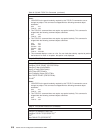Setting the Maximum Transmission Unit
The maximum transmission unit (MTU) parameter that you can enter on the
Add
TCP/IP Interface
(ADDTCPIFC) command,
Add TCP/IP Route
(ADDTCPRTE)
command,
Change TCP/IP Interface
(CHGTCPIFC) command, or
Change TCP/IP
Route
(CHGTCPRTE) command depends on the type of line that you use. The
following is a list of the maximum MTU values that you can specify, based on the
line type:
Asynchronous (SLIP) 1006
DDI 4352
Ethernet 802.3 1492
Ethernet Version 2 1500
Frame relay 8177
Point-to-Point (PPP) 4096
Token ring (4 meg) 4060
Token ring (16 meg) 16388
Wireless 802.3 1492
Wireless Version 2 1500
X.25 4096
Notes:
1. TCP/IP processing uses a small part of each datagram. Therefore, the whole
datagram size is unavailable for user data.
2. The value of the maximum transmission unit used by TCP/IP processing
depends on the value that you specify for the route on the MTU parameter of
the route or interface commands mentioned previously. It also depends on the
type of physical line that you use, the maximum frame size of the network line,
and the SSAP maximum frame size.
Determining the Maximum Size of Datagrams
For a communications line, specify the maximum frame size on the appropriate
Create Line Description
command. The maximum frame size is compared to the
MTU value of the route or interface. TCP/IP uses the lesser of these two values to
determine the maximum size of datagrams that it sends by over this line.
For example, if you specify 1024 for the MTU parameter for a route attached to a
communications line and the line description contained a value of 512 for a
maximum frame size, the maximum datagram size value for the route that TCP/IP
uses is 512. If the line is varied
off
and you change the maximum frame size on the
Token-ring line description to 1994, and then the line is varied
on
, the maximum
transmission unit used for the route is reset to 1024 when the next TCP/IP operation
occurs that causes a datagram to be sent.
Appendix A. Configuring a Physical Line for TCP/IP Communication 507


















